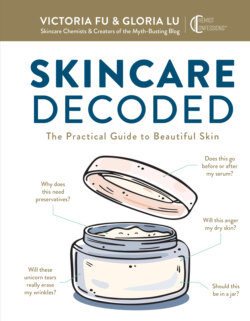Читать книгу Skincare Decoded - Victoria Fu - Страница 44
На сайте Литреса книга снята с продажи.
ОглавлениеSKINCARE DECODED • 50 MOISTURIZERS • 51
The Science of Moisturizers
E
ven though scoping out a good moisturizer may seem confusing, there’s
actually some method to the madness. You can divide moisturizers into
three categories of ingredients based on their function: humectants, emollients,
and occlusives. These three categories work together to fullfill your skin’s
moisturizing needs. Understanding how these ingredients work, and finding a
balance of the categories, is the key to cracking your skin’s moisturizing code.
The reality is that your skin will constantly change.
So, instead of hitting the reset button and tossing
out your current moisturizer—the one that took you
forever to find—figure out which of these categories
you might need just a little more of, and you’ll
master your moisturizing needs through the seasons.
Hopefully, thinking about it in this manner will help you
confidently troubleshoot and adjust your moisturizing
routine when your skin decides to be dramatic.
Category 1: Humectants (The Water Stuff)
Humectants are water-grabbing ingredients that help
your skin maintain a healthy moisture level, which is
key to maintaining that desirable, supple feel. Your
skin naturally has its own water-holding system in the
form of natural moisturizing factors (NMFs), and the
humectants in skincare are there to support them. Some gold-star humectants
used in moisturizers are glycerin, hyaluronic acid, and glycols. Humectants
are so important that many skincare products are humectant-centric, such as
essences, ampoules, hydrating serums, and mists.
Who needs humectants? From the oiliest to the dryest skin, every type can
enjoy the benefits of humectants. They are especially crucial if you want your
dry skin to achieve that supple look!
Humectants
Emollients
Occlusives
LOTION VS. CREAM
